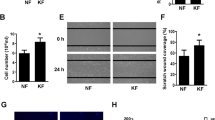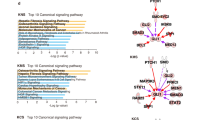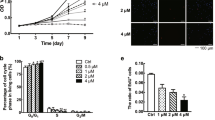Abstract
Keloids, partially considered as benign tumors, represent the most extreme example of cutaneous scarring that uniquely afflicts humans as a pathological response to wound healing. It is characterized by excessive deposition of collagen and other extracellular matrix components by dermal fibroblasts. Upon cutaneous injury, cocktails of chemokines, cytokines and growth factors are secreted temporally and spatially to direct appropriate responses from neutrophils, macrophages, keratinocytes and fibroblasts to facilitate normal wound healing. Signal transducer and activator of transcription 3 (Stat3) is an oncogene and a latent transcription factor activated by various cytokines and growth factors. We investigated the possible role of Stat3 in keloid scar pathogenesis by examining skin tissue and cultured fibroblasts from keloid-scarred patients. We observed enhanced expression and phosphorylation of Stat3 in keloid scar tissue, and in cultured keloid fibroblasts (KFs) in vitro. Increased activation of Janus kinase (Jak)2, but not Jak1, was detected in KFs, and suppression of Jak2 by its inhibitor repressed Stat3 Y705 phosphorylation. Inhibition of Stat3 expression and phosphorylation by short interfering RNA or Cucurbitacin I resulted in the loss of collagen production, impaired proliferation and delayed cell migration in KFs. We show, for the first time, a role of Stat3 in keloid pathogenesis. Inhibitors of Stat3 may be useful therapeutic strategies for the prospective treatment of keloid scars.
This is a preview of subscription content, access via your institution
Access options
Subscribe to this journal
Receive 50 print issues and online access
$259.00 per year
only $5.18 per issue
Buy this article
- Purchase on SpringerLink
- Instant access to full article PDF
Prices may be subject to local taxes which are calculated during checkout







Similar content being viewed by others
Accession codes
References
Abergel RP, Pizzurro D, Meeker CA, Lask G, Matsuoka LY, Minor RR et al. (1985). J Invest Dermatol 84: 384–390.
Alster TS, Tanzi EL . (2003). Am J Clin Dermatol 4: 235–243.
Babu M, Diegelmann R, Oliver N . (1989). Mol Cell Biol 9: 1642–1650.
Babu M, Diegelmann R, Oliver N . (1992). J Invest Dermatol 99: 650–655.
Blaskovich MA, Sun J, Cantor A, Turkson J, Jove R, Sebti SM . (2003). Cancer Res 63: 1270–1279.
Bowman T, Garcia R, Turkson J, Jove R . (2000). Oncogene 19: 2474–2488.
Bromberg JF, Wrzeszczynska MH, Devgan G, Zhao Y, Pestell RG, Albanese C et al. (1999). Cell 98: 295–303.
Calderon M, Lawrence WT, Banes AJ . (1996). J Surg Res 61: 343–347.
Chan KS, Sano S, Kiguchi K, Anders J, Komazawa N, Takeda J et al. (2004). J Clin Invest 114: 720–728.
Cosman B, Crikelair GF, Gaulin JC, Lattes R . (1961). Plast Reconstr Surg 27: 335–358.
Darnell Jr JE . (1997). Science 277: 1630–1635.
Darnell Jr JE, Kerr IM, Stark GR . (1994). Science 264: 1415–1421.
Dauer DJ, Ferraro B, Song L, Yu B, Mora L, Buettner R et al. (2005). Oncogene 24: 3397–3408.
Diegelmann RF, Cohen IK, McCoy BJ . (1979). J Cell Physiol 98: 341–346.
Edmondson SR, Thumiger SP, Werther GA, Wraight CJ . (2003). Endocr Rev 24: 737–764.
Haisa M, Okochi H, Grotendorst GR . (1994). J Invest Dermatol 103: 560–563.
Lee TY, Chin GS, Kim WJ, Chau D, Gittes GK, Longaker MT . (1999). Ann Plast Surg 43: 179–184.
Leong PL, Andrews GA, Johnson DE, Dyer KF, Xi S, Mai JC et al. (2003). Proc Natl Acad Sci USA 100: 4138–4143.
Lim IJ, Phan TT, Bay BH, Qi R, Huynh H, Tan WT et al. (2002). Am J Physiol Cell Physiol 283: C212–C222.
Mustoe TA . (2004). BMJ 328: 1329–1330.
Naitoh M, Hosokawa N, Kubota H, Tanaka T, Shirane H, Sawada M et al. (2001). Biochem Biophys Res Commun 280: 1316–1322.
Ng DC, Lin BH, Lim CP, Huang G, Zhang T, Poli V et al. (2006). J Cell Biol 172: 245–257.
Ragoowansi R, Cornes PG, Glees JP, Powell BW, Moss AL . (2001). Br J Plast Surg 54: 504–508.
Sano S, Itami S, Takeda K, Tarutani M, Yamaguchi Y, Miura H et al. (1999). EMBO J 18: 4657–4668.
Singer AJ, Clark RA . (1999). N Engl J Med 341: 738–746.
Song H, Wang R, Wang S, Lin J . (2005). Proc Natl Acad Sci USA 102: 4700–4705.
Sun J, Blaskovich MA, Jove R, Livingston SK, Coppola D, Sebti SM . (2005). Oncogene 24: 3236–3245.
Takeda K, Akira S . (2000). Cytokine Growth Factor Rev 11: 199–207.
Takeda K, Noguchi K, Shi W, Tanaka T, Matsumoto M, Yoshida N et al. (1997). Proc Natl Acad Sci USA 94: 3801–3804.
Tuan TL, Nichter LS . (1998). Mol Med Today 4: 19–24.
Turkson J, Ryan D, Kim JS, Zhang Y, Chen Z, Haura E et al. (2001). J Biol Chem 276: 45443–45455.
Wen Z, Zhong Z, Darnell Jr JE . (1995). Cell 82: 241–250.
Werner S, Grose R . (2003). Physiol Rev 83: 835–870.
Wu Y, Zhang Q, Ann DK, Akhondzadeh A, Duong HS, Messadi DV et al. (2004). Am J Physiol Cell Physiol 286: C905–C912.
Xue H, McCauley RL, Zhang W . (2000). J Surg Res 89: 74–77.
Yang GP, Lim IJ, Phan TT, Lorenz HP, Longaker MT . (2003). Wound Repair Regen 11: 411–418.
Yoshimoto H, Ishihara H, Ohtsuru A, Akino K, Murakami R, Kuroda H et al. (1999). Am J Pathol 154: 883–889.
Younai S, Nichter LS, Wellisz T, Reinisch J, Nimni ME, Tuan TL . (1994). Ann Plast Surg 33: 148–151.
Acknowledgements
We are grateful to Dr Garry Nolan for the retroviral Phoenix packaging cell line. We thank Dr Birgit Lane for helpful discussions, Zheng Qi, Guo Ke, Li Jie and Bin Qi from the Histology Unit at the Institute of Molecular and Cell Biology, Singapore, for their kind assistance. The research work at the Institute of Molecular and Cell Biology was supported by the Agency of Science, Technology and Research (A*STAR), Singapore. This research was also supported by A*STAR-Biomedical Research Council (BMRC) grant 02/1/21/19/106 (to Lim IJ and Phan TT). Xinmin Cao is also an adjunct professor at the Department of Biochemistry, National University of Singapore, Singapore.
Author information
Authors and Affiliations
Corresponding author
Additional information
Supplementary Information accompanies the paper on the Oncogene website (http://www.nature.com/onc).
Supplementary information
Rights and permissions
About this article
Cite this article
Lim, C., Phan, TT., Lim, I. et al. Stat3 contributes to keloid pathogenesis via promoting collagen production, cell proliferation and migration. Oncogene 25, 5416–5425 (2006). https://doi.org/10.1038/sj.onc.1209531
Received:
Revised:
Accepted:
Published:
Issue Date:
DOI: https://doi.org/10.1038/sj.onc.1209531
Keywords
This article is cited by
-
Nifuroxazide ameliorates pulmonary fibrosis by blocking myofibroblast genesis: a drug repurposing study
Respiratory Research (2022)
-
LncRNA TRHDE-AS1 inhibit the scar fibroblasts proliferation via miR-181a-5p/PTEN axis
Journal of Molecular Histology (2021)
-
Nintedanib inhibits keloid fibroblast functions by blocking the phosphorylation of multiple kinases and enhancing receptor internalization
Acta Pharmacologica Sinica (2020)
-
Th-17 regulatory cytokines inhibit corticosteroid induced airway structural cells apoptosis
Respiratory Research (2016)
-
Sorafenib exerts an anti-keloid activity by antagonizing TGF-β/Smad and MAPK/ERK signaling pathways
Journal of Molecular Medicine (2016)



